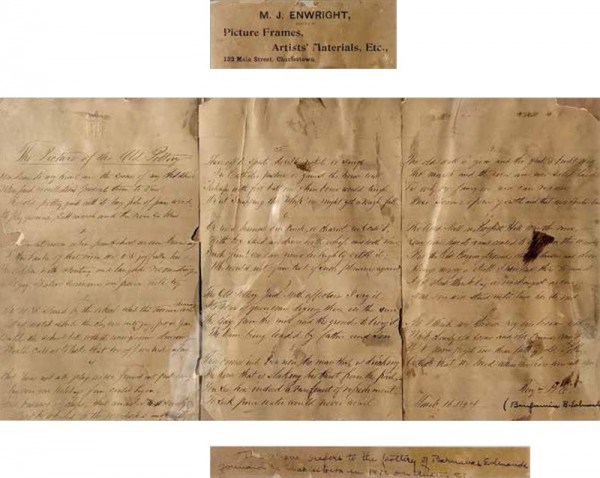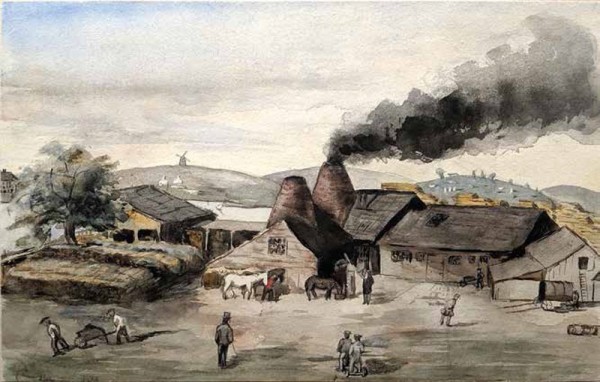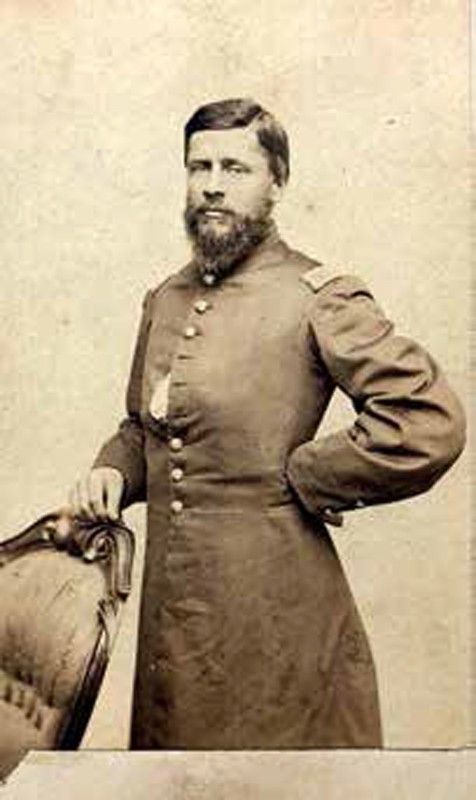
Benjamin B. Edmands, “The Picture of the Old Pottery,” Charlestown, Massachusetts, March 16, 1894. Ink on paper. (Courtesy, Nicholas P. Bruno, M.D.)

Unknown artist, The Picture of the Old Pottery, ca. 1894. Watercolor on paper. 12" x 7 5/8". (Courtesy, Nicholas P. Bruno, M.D.)

Carte de visite of Lieutenant Benjamin B. Edmands, prepared by Charles Wallace Chute, 13 Tremont Row, Boston, Massachusetts, ca. 1865. Albumen print on card. Overall size 2 3/8" x 4".
Editor’s Foreword: During the preparation of Ceramics in America 2019, contributor Lorraine German brought to our attention previously unpublished material related to the potworks first established in Charlestown, Massachusetts, in 1812 by Barnabas Edmands and his brother-in-law William Boroughs. This documentation includes a handwritten poem (fig. 1), dated March 16, 1894, of eleven stanzas on three sheets of lined paper, signed with the initials “B. E.” Accompanying the poem is a watercolor rendering (fig. 2) of the potworks, set within the undeveloped landscape of early-nineteenth-century Charlestown. Beneath the initials, in another hand, are two annotations: “Benjamin B. Edmands” and “The above refers to the pottery of Barnabas Edmands founded in Charlestown in 1812(3) on Austin St.”
The painter of the watercolor is unclear, although a partial but illegible -signature is seen on the bottom left of the composition. The highly detailed scene is undoubtedly a memory depiction, however, and seems to be contemporary to the poem. Perhaps the artist was a close relative. Much of the poem relates to this watercolor, which suggests that the artwork was done first and the poem was inspired by the scene.
The watercolor and the poem are mounted together in a frame that bears the label:
M. J. Enwright
DEALER IN
Picture Frames,
Artists Materials, Etc.,
132 Main Street, Charlestown
M. J. Enwright is listed in the Boston art guide and artists’ directory published by Ekin Wallick, (Boston, Mass.: Wheat Pub. Co., 1892).[1]
Benjamin Bruce Edmands (b. 1825), one of the sons of Barnabas Edmands, was working in his father’s pottery by 1840 at the age of fifteen.[2] The Edmands and Co. pottery was a major manufacturer among New England potteries, and by 1845 employed fourteen workers and produced $18,000 of stoneware per year.[3] The opening verse of the poem resolutely frames his recollections of this childhood period.
By 1850 Barnabas had moved the pottery to Medford Street on the Mystic River, subsequently retiring and selling the business to his sons Edward Townsend and Thomas Russell Boroughs. The pottery continued under several different ownerships until it closed in 1905.
Benjamin Edmands married Amy Ann (Hood) Edmands around 1861, and is listed as a working potter until his enlistment in August 1862 as a private in the newly formed 36th Massachusetts Volunteer Infantry. He subsequently was commissioned as a second lieutenant. Later he served as a first lieutenant (fig. 3) in the famed 54th Massachusetts Volunteer Infantry, the second African-American regiment, until August 1865. The 54th Regiment was depicted in the 1989 Academy Award–winning film Glory, starring Matthew Broderick, Denzel Washington, and Morgan Freeman.
After his discharge, Benjamin appears not to have returned to the -pottery business; later census data show him as a manufacturer of braiding machines used in the production of rope until his death in 1914.[4] Although we have limited biographic information about his life, Benjamin’s poetic description of his father’s stoneware manufactory and the accompanying watercolor offer a tantalizing glimpse into the layout and everyday workings of an American industry that often leaves little behind in the historical record other than the pots themselves. We are fortunate to present Benjamin’s own words here.
The Picture of the Old Pottery
How dear to my heart are the scenes of my childhood
When fond recollections present them to view;
The old pottery yard with its big piles of pine wood,
Its playground, salt marsh and the river so blue.2
So often at noon when from school we were bounding
To the banks of that river we wo’d joyfully hie,
The welkin with shouting and laughter resounding
As gay sportive swimmers our powers wo’d try.3
Or we’d stand by the wheel which the turners were spinning,
And watch while the clay rose into jug, pot, or jar,
Until the school bell with its unwelcome dinning
Would call us to tasks that we oft wished afar.4
But ’twas not all play as we found out full early,
Ere ever our holiday’s fun could begin,
Then barrows of chips that number most surely
Must be wheeled to the woodshed and neatly put in.5
Then off to sports—double wickets or single,
The Catholic pasture or ‘gainst the house wall
Perhaps with foot ball our shin bones would tingle
Or at “Snapping the Whip” one might get a rough fall.6
Or we’d harness our truck, or chariot we’d call it,
With boy-steed an driver with whip and with rein,
Such fun! One can never too highly extoll it;
Who would not fain taste of such pleasures again?7
The Old Pottery Yard—with affection I say it.
Its rows of green ware drying there in the sun,
The clay from the mill and the grinder to bring it,
The team being loaded by father and son.8
Then comes into view now, the man that is drinking,
The horse that is slaking his thirst from the pail,
You see here indeed a rare fount of refreshment,
To seek purer water would never avail.9
The old well is gone and the yard is built over;
The marsh and the river are now solid land.
‘Tis only by fancy we now can recover
Those scenes of our youth that once sportive band.10
The wind mill on Prospect Hill over the river,
Long time has its vanes ceased to whirl in the wind;
But the Old Burying Ground with its daisies and clover
Brings many a stroll I have had there to mind,
As it stands there today as unchanged as ever,
And ever will stand until time has its end.11
As I think now thereon my eyes become wat’ry,
While dearly old scenes and old friends come to view,
We’ll never forget our dear father’s old pottery,
Or those that we loved when our lives were all new.
—Benjamin B. Edmands, March 16, 1894
http://www.ebooksread.com/authors-eng/ekin-wallick/boston-art-guide-and-artists-directory-tso/page-8-boston-art-guide-and-artists-directory-tso.shtml.
Only summary information has been published on Barnabas Edmands and the various manifestations of his potteries in Charleston. The first and most complete summary is by Lura Woodside Watkins, Early New England Potters and Their Wares (Cambridge, Mass.: Harvard University Press, 1950), pp. 84–85. Additional information about the Austin Street location works can be found in Brandt Zipp, “A Pot for the President, Made at the Foot of Bunker Hill—Charlestown, Massachusetts,” Crocker Farm Magazine, posted on February 18, 2010: https://www.crockerfarm.com/blog/2010/02/charlestown-massachusetts-stoneware/.
Watkins, Early New England Potters and Their Wares, p. 85.
For more information about Edmands, see https://www.wikitree.com/wiki/Edmands-35#Biography.
